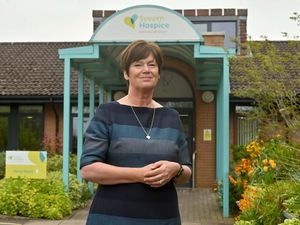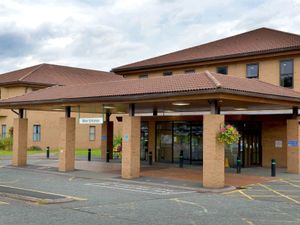My onward journey away from the danger of diabetes
BILL MCCARTHY explains how he continues to keep diabetes at bay thanks to a lifestyle course
Watch more of our videos on ShotsTV.com
and on Freeview 262 or Freely 565
I still have mixed feelings as I step onto the scales. These days it's not the trepidation of seeing how much I weigh, but the disappointment that I have not lost more.
Not really embarrassing any more, well maybe a little, but certainly frustrating. This is despite the fact the around four stone, more than 26kg have been shed since embarking on a diabetes prevention programme back in October.
There's a definite body shape change, with lots of bulges having disappeared, but I remain, heavier than I look, or so I'm told. One poor soul estimated my weight at around the 12.5 to 13 stone mark. If only, but thanks anyway. Specsavers beckons I fear.
My wife thinks its because muscle weighs more than fat. Hmmm. This comes after a nine-month programme came to an end recently.
I had joined it after a blood test had shown that I had become pre-diabetic, which means you are not producing enough insulin and that can lead to contracting full blown type 2 diabetes, a disease that even now is little understood despite so m any people being affected by it. Up to five million in the UK.
I had been referred by my GP after the blood test and the weigh-in at the first session was a shocker
The session was run by lifestyle coach from Living Well Taking Control (LWTC), a providers commissioned through NHS England to deliver the Healthier You Diabetes Prevention Programme throughout England.
The programme consists of a series of sessions of around an hour spread over a nine month period discussing issues of diet, exercise, mental wellbeing, the medical implications of the disease and a host of other related issues.
Part of the plan is regular checks on weight and waist size, which can be embarrassing.
To say it has been easy would not be accurate. OK, it would be lying. The period has involved a dramatic change to dietary habits. And the good news is that the latest blood tests reveal that I am no longer pre-diabetic.
With the guidance of the course, you are encouraged to take more fibre, fewer carbohydrates, avoid too much sugar and moderate your eating and drinking.
So it was out with the chips, curries, bread, booze and pasta. In with fruit, veg, pulses grains and a measure of temperence with the booze.
The hardest thing was cutting alcohol by around two-thirds. I am a social drinker and like the pub. But there you go. Yet another pleasure severely curtailed. Also cutting back on alcohol means less socialising.
It also means a healthier bank balance. So there is an upside.The course also covers lifestyle, such as mental health and wellbeing, fitness, the importance of proper sleep.

The change has also affected my home relationship as my wife has helped me to adapt to eating more fruit and veg, pulses and fibres.
At first a slightly alien concept, but now a more than acceptable alternative as you start to think about how you are fuelling your body.That's not to say you cannot have the occasional blowout.
In the meantime the weight reduced gradually and other things started to click. I felt fitter, aided by long walks and started sleeping better.
Having safely navigated the Christmas bloatfest, the ultimate test was a week at a fully inclusive resort in Marmaris, Turkey.
A chance to let your hair and guard down and indulge. I found I was able to do this, but adjusting my usual holiday routine. This involved two or three mile walks daily together with half an hour in the pool. Also a couple of gentle gym workouts.
None of this proved a problem and there was still left plenty of time for a thoroughly enjoyable break without a guilt trip on return. I have even lost a pound or two.
The course has now come to an end, but the project needs to stay on course. But its not just about weight. Key elements include sleep and muscular strength.
My particular course was led by coach Rachel Downer, who covers the Black Country, Birmingham and Solihull, she explained: "As we get older, we know that we start to lose our lean muscle mass (a rate of 3-5 per cent per decade after the age of 30).
"Lean muscle mass is linked to our bone health and our metabolism. The stronger our muscles the better our basal metabolic rate which means we burn calories more efficiently. By improving our body composition and reducing our visceral fat, we also decrease the likelihood of insulin resistance, which can lead to type 2 diabetes."
She added that if you sleep better and you also burn calories more efficiently.
An evidence review commissioned by Public Health England and the Centre for Ageing Better has found that muscle and bone strengthening and balance activities continue to have great health benefits for all adults, including older adults aged 65 years and over.
In older adults, poor muscle strength increases the risk of a fall by 76 per cent and those who have already had a fall are three times more likely to fall again. Strengthening and balance activities not only help to prevent this, but also help improve your mood, sleeping patterns, increase your energy levels and reduce the risk of an early death.
Activities found to have the most benefit for muscle and bone strengthening include ball games, racket sports, dance and nordic walking.
Resistance training is also useful. This is usually training with weights, but including body weight exercises which can be performed anywhere.
So there you have it, the really hard bit is over. Or is it? An even bigger challenge I think is maintaining the changes. The temptation to return to bad habits is always there. Still I could always say any weight gain is down to increased muscle.
HOW DO YOU KNOW IF YOU HAVE DIABETES?
Symptoms can include frequent urination especially at night, feeling more tired than usual, cuts and wounds taking longer to heal and blurred vision gum disease as well as increasing risk of both heart attack and stroke.
Over time, it can cause other serious health problems like nerve damage, amputation, sight loss and kidney damage
The HbA1c test reflect the average level of glucose in your blood during the last 2-3 months. If not well controlled, your blood glucose levels will be high causing higher HbA1c levels.
In simple terms, there is a number scale for your HbA1c range. From 20-41 is seen as normal, 42 to 48 is pre-diabetic and 48 and above is diabetic.
I had tripped over to number 42. Hence pre-diabetic, a depressing and thought-provoking diagnoses. The good news is that after another blood test, the reading has now dropped to 39, in other words a normal blood reading and no longer pre-diabetic.
According to Diabetes UK, the number of people living with diabetes has topped five million for the first time, last year's analysis showed.
The group has called on the government to ensure that national and local health systems put diabetes at the heart of their plans ensuring they identify more people at risk of type 2 diabetes, reduce health inequalities, and target communities where diabetes prevalence is high.
The figures show that 4.3 million people are now living with a diagnosis of diabetes in the UK. Registration figures for 2021-22 are up by 148,951 from 2020-21, and more than 2.4 million people are at high risk of developing type 2 diabetes in the UK.
Approximately 90 per cent of diagnoses are of type 2 diabetes, and around eight per cent of diagnoses are type 1 diabetes, with the other forms of the condition making up





